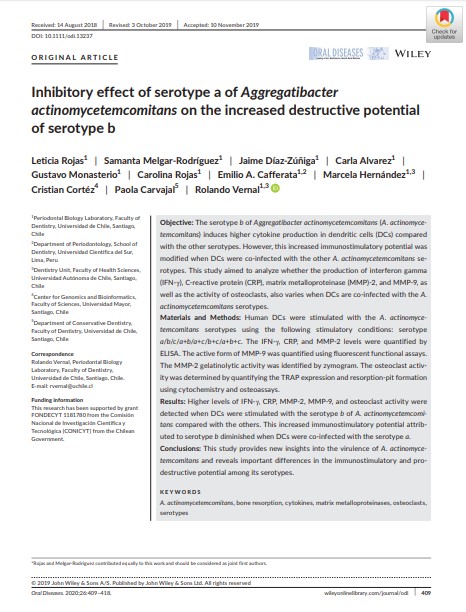Inhibitory effect of serotype a of Aggregatibacter actinomycetemcomitans on the increased destructive potential of serotype b

Fecha
2020Autor
Cortez, Cristián [Univ Mayor, Ctr Genom & Bioinformat, Fac Sci, Santiago, Chile]
Rojas, Leticia; Melgar-Rodríguez, Samanta; Díaz-Zuniga, Jaime; Alvarez, Carla; Monasterio, Gustavo; Rojas, Carolina; Cafferata, Emilio A.; Hernández, Marcela; Carvajal, Paola; Vernal, Rolando
Ubicación geográfica
Notas
HERRAMIENTAS
Acceda a títulos restringidos
¿Cómo descargar?Resumen
Objective The serotype b of Aggregatibacter actinomycetemcomitans (A. actinomycetemcomitans) induces higher cytokine production in dendritic cells (DCs) compared with the other serotypes. However, this increased immunostimulatory potential was modified when DCs were co-infected with the other A. actinomycetemcomitans serotypes. This study aimed to analyze whether the production of interferon gamma (IFN-gamma), C-reactive protein (CRP), matrix metalloproteinase (MMP)-2, and MMP-9, as well as the activity of osteoclasts, also varies when DCs are co-infected with the A. actinomycetemcomitans serotypes. Materials and Methods Human DCs were stimulated with the A. actinomycetemcomitans serotypes using the following stimulatory conditions: serotype a/b/c/a+b/a+c/b+c/a+b+c. The IFN-gamma, CRP, and MMP-2 levels were quantified by ELISA. The active form of MMP-9 was quantified using fluorescent functional assays. The MMP-2 gelatinolytic activity was identified by zymogram. The osteoclast activity was determined by quantifying the TRAP expression and resorption-pit formation using cytochemistry and osteoassays. Results Higher levels of IFN-gamma, CRP, MMP-2, MMP-9, and osteoclast activity were detected when DCs were stimulated with the serotype b of A. actinomycetemcomitans compared with the others. This increased immunostimulatory potential attributed to serotype b diminished when DCs were co-infected with the serotype a. Conclusions This study provides new insights into the virulence of A. actinomycetemcomitans and reveals important differences in the immunostimulatory and pro-destructive potential among its serotypes.
Coleccion/es a la/s que pertenece:
Si usted es autor(a) de este documento y NO desea que su publicación tenga acceso público en este repositorio, por favor complete el formulario aquí.